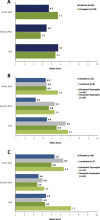The challenges of living with and managing epidermolysis bullosa: insights from patients and caregivers
- PMID: 31900176
- PMCID: PMC6942340
- DOI: 10.1186/s13023-019-1279-y
The challenges of living with and managing epidermolysis bullosa: insights from patients and caregivers
Abstract
Background: Little information is available regarding the burden of living with and managing epidermolysis bullosa, including the distinct challenges faced by patients with different disease types/subtypes.
Methods: A 90-question/item survey was developed to collect demographics, diagnostic data, management practices, and burden of illness information for patients with epidermolysis bullosa living in the United States. Recruitment was conducted via email and social media in partnership with epidermolysis bullosa patient advocacy organizations in the United States, and the survey was conducted via telephone interview by a third-party health research firm. Respondents aged ≥ 18 years with a confirmed diagnosis of epidermolysis bullosa or caring for a patient with a confirmed diagnosis of epidermolysis bullosa were eligible to participate in the survey.
Results: In total, 156 responses were received from patients (n = 63) and caregivers (n = 93) representing the epidermolysis bullosa types of simplex, junctional, and dystrophic (subtypes: dominant and recessive). A large proportion of patients (21%) and caregivers (32%) reported that the condition was severe or very severe, and 19% of patients and 26% of caregivers reported a visit to an emergency department in the 12 months prior to the survey. Among the types/subtypes represented, recessive dystrophic epidermolysis bullosa results in the greatest wound burden, with approximately 60% of patients and caregivers reporting wounds covering > 30% of total body area. Wound care is time consuming and commonly requires significant caregiver assistance. Therapeutic options are urgently needed and reducing the number and severity of wounds was generally ranked as the most important treatment factor.
Conclusions: Survey responses demonstrate that epidermolysis bullosa places a considerable burden on patients, their caregivers, and their families. The limitations caused by epidermolysis bullosa mean that both patients and caregivers must make difficult choices and compromises regarding education, career, and home life. Finally, survey results indicate that epidermolysis bullosa negatively impacts quality of life and causes financial burden to patients and their families.
Keywords: Caregivers; Disease burden; Epidermolysis bullosa; Financial burden; Management; Patients; Quality of life; Survey; Wound care.
Conflict of interest statement
ALB has served as a consultant and an investigator for Amicus Therapeutics/Scioderm and Castle Creek, and as an investigator for Amryt, Fibrocell, ProQR, and Phoenix Tissue Repair.
JW, NP, AR, HL, ML, and JGa, are employees of and hold stock in Amicus Therapeutics.
JGe is the co-founder and vice chair on the board of Profession Patient Advocates in Life Sciences; a member of the board of trustees for the Healthcare Institute of New Jersey; a member of the board of directors for the Together Strong Foundation for NPC, and an employee of, and a stock holder and patent holder in, Amicus Therapeutics.
BK is an employee of Debra of America.
MH is an employee of EB Research Partnership.
DFM has served as an investigator for Amicus Therapeutics, Amryt, Castle Creek, and Shire, and has served as an advisor for Amicus and Shire.
Figures




References
-
- Ma JE, Hand JL. What's new with common genetic skin disorders? Minerva Pediatr. 2017;69:288–297. - PubMed
Publication types
MeSH terms
LinkOut - more resources
Full Text Sources

